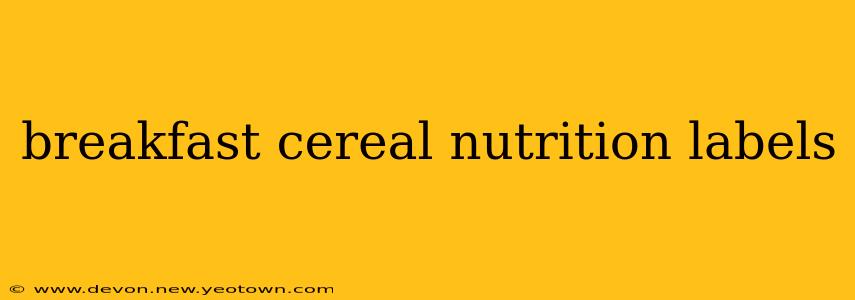Breakfast cereal. The quintessential morning meal, a quick grab-and-go, a nostalgic trip back to childhood. But navigating the seemingly endless aisles of colorful boxes can feel like a minefield. Understanding the nutrition label is your key to making informed, healthy choices. This isn't just about calories; it's about understanding the ingredients that fuel your day. Let's embark on this crunchy journey together!
My name is Sarah, and I've spent years researching nutrition and food labels. I'm passionate about helping people make healthier choices without sacrificing taste or enjoyment. I'll guide you through the complexities of deciphering breakfast cereal nutrition labels, revealing hidden sugars and highlighting nutritional powerhouses.
What are the Key Things to Look For on a Breakfast Cereal Nutrition Label?
The nutrition label is your roadmap to a healthier breakfast. Don't be intimidated by the numbers and percentages; let's break them down. The most crucial aspects to focus on are:
- Serving Size: This is the foundation. Everything else is relative to this amount. Pay close attention, as some boxes might deceptively present a small serving size, making the overall nutritional content seem better than it is.
- Calories: A general guideline, but remember that calorie needs vary widely depending on age, activity level, and overall health goals.
- Total Fat, Saturated Fat, and Trans Fat: Limit saturated and trans fats, as they contribute to heart disease. Look for cereals low in these.
- Cholesterol: Generally not a significant concern in cereals, as they are typically cholesterol-free.
- Sodium: Excessive sodium contributes to high blood pressure. Opt for lower-sodium options.
- Total Carbohydrate, Dietary Fiber, and Sugars: This is where it gets interesting. Focus on cereals with higher fiber content and lower added sugar. Fiber promotes gut health and keeps you feeling full, while excessive sugar leads to energy crashes and other health problems.
- Protein: Protein is essential for building and repairing tissues. Look for cereals that offer a decent amount of protein, particularly if you're aiming for a more substantial breakfast.
- Vitamins and Minerals: Many cereals are fortified with essential vitamins and minerals. Check for the presence of those that are important for your daily intake.
How Much Sugar is Too Much in Breakfast Cereal?
This is a frequently asked question, and the answer isn't a magic number. However, a good rule of thumb is to look for cereals with less than 5 grams of added sugar per serving. Remember to check the added sugar content, not just the total sugar. Some sugars naturally occur in grains, while others are added during processing.
What About Whole Grains and Fiber in Breakfast Cereal?
Whole grains are crucial for digestive health and overall well-being. Look for cereals that list whole grains as the first ingredient, indicating a higher whole-grain content. Aim for at least 5 grams of fiber per serving. High-fiber cereals can help you feel full and satisfied, which can aid in weight management.
Are There Healthy Breakfast Cereal Options Available?
Absolutely! Many brands are now producing cereals that prioritize whole grains, fiber, and lower sugar content. Read labels carefully and compare different brands to find the healthiest option that fits your preferences and dietary needs. Don't be afraid to experiment until you find a cereal you truly enjoy!
How Can I Compare Different Cereals Based on Their Nutrition Labels?
Direct comparison is key! Write down the key nutritional values (serving size, calories, sugars, fiber, etc.) from different cereals you are considering and create a simple chart to see which one best fits your needs. This will allow you to make an informed choice based on your dietary preferences and goals.
Conclusion: Making Smart Breakfast Choices
Navigating the breakfast cereal aisle doesn't have to be daunting. By understanding the information on the nutrition label and focusing on key nutrients like fiber and whole grains, while minimizing added sugars and unhealthy fats, you can make healthy and delicious breakfast choices that will energize your day. Remember, making small changes can have a big impact on your overall health and well-being. Start your day the healthy way!

